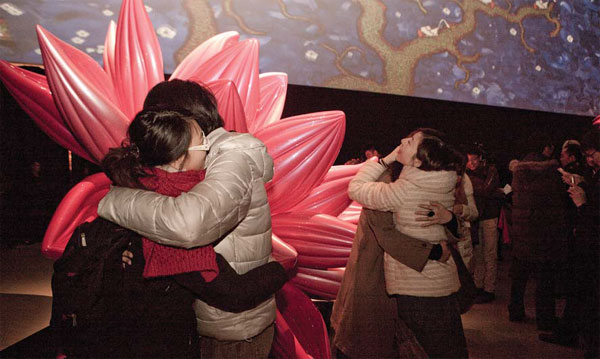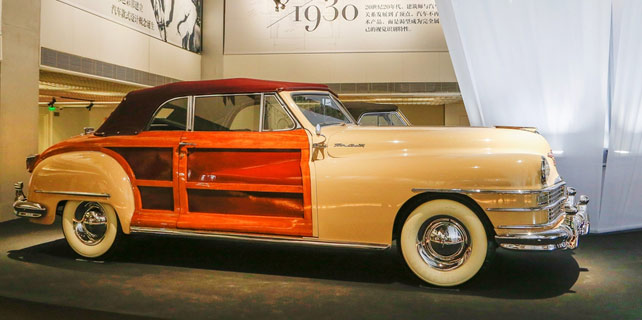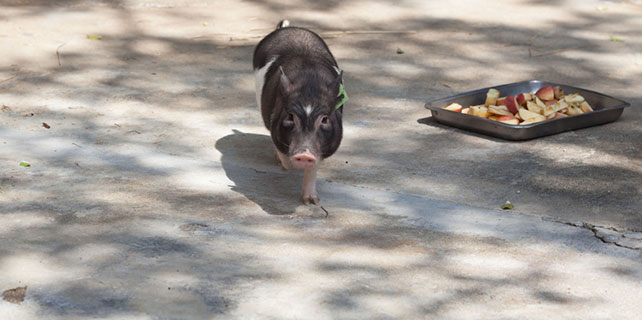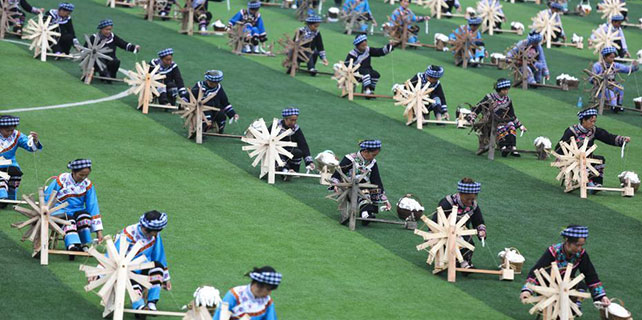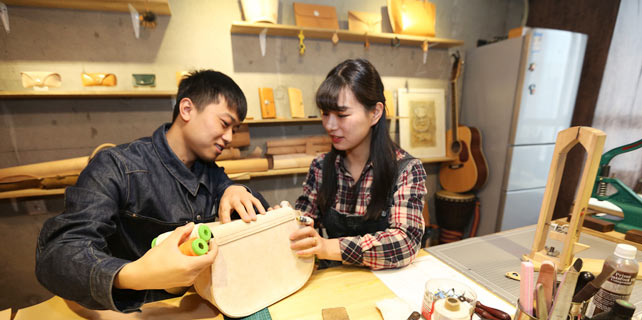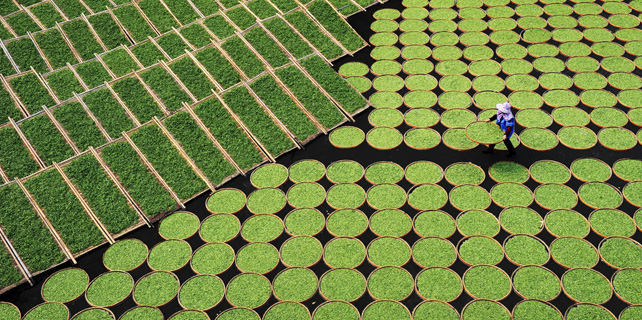The art of fostering appreciation
Art museums and galleries in China, once regarded by many as meeting places for the elite, are now attracting the masses
Gao Peng, a museum curator, says the most difficult yet moving embrace he has ever seen took place between a man and his daughter in the gallery of Today Art Museum in Beijing, which Gao has directed for the past four years.
"Twice the man tried to hold his daughter in his embrace and twice the teenage girl broke away, feeling uncomfortable, I guess. Then, the third and final time, they clung to one another for 13 minutes and 14 seconds. After they parted, the father said to his daughter: 'The day will soon come when you'll grow up and get married. ... But you know what? Dad really wants to hold you for as long as I can, in the same way as I held you when you were an infant.
|
A project organized by Today Art Museum asks the participating pairs to embrace each other for 13 minutes 14 seconds. Provided to China Daily |
"Tears streamed down her face," Gao says.
The father and daughter were among about 200 pairs of people who turned up at Today Art Museum three years ago to take part in an art program that required a long embrace. It had to last 13 minutes and 14 seconds.
"In Chinese, the number sequence 1, 3, 1, 4 enunciated as single digits sounds like 'a lifetime'," Gao says. "Of all things, I'm sure that the memory of that experience will last for a lifetime for all who took part."
Yet the purpose of this program was more about bringing people to see someone they thought they knew than about simply expressing love, he says.
"Thirteen minutes is a long time. Initially most people didn't feel much. Two people must have known each other quite well for them to come along as a pair. Then, as time passed, feelings of embarrassment and discomfort began to grow, like the vapor on a chilled piece of glass. Both felt tempted to break away. Some even admitted to having developed a visceral feeling of disgust."
While some indeed chose to put an end to the prolonged embrace, others persisted and later talked to Gao about the gradual disappearance of awkward feelings, replaced by a deeper and more profound sense of mutual attachment they had never experienced before.
"Believe it or not, there's usually a glass wall between you and your loved ones. The project we did helped bring out the invisible for both sides to see. If they have the will, they can walk through it. The project is underwritten by what I believe is the fundamental purpose of art: to arouse and to enable the expression of emotions."
Last year the museum, a long-time presence on the country's contemporary art scene, received an estimated 300,000 visitors. A large part of that number is drawn from the gallery's trendy neighborhood, populated by art-conscious young businesspeople, some of whom have been educated overseas.
"People with similar backgrounds form the bulk of the audience for China's contemporary art," Gao says. "And they make a conscious effort to introduce art to their next generation, in a more open-minded way."
Over the past decade Chinese art and artists have been making headlines in international auctions worldwide. Parallel to that is a phenomenal increase of art audiences inside the country, especially in big cities. Art museums and galleries, public and private, have ceased being the preserve of art professionals and started to be a public platform where ideas meet and clash.
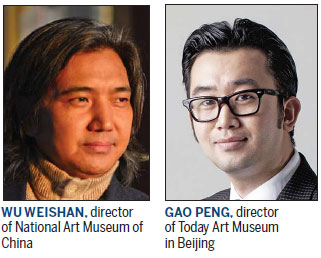
Judging by visitor numbers, the most prominent landmark on the country's art map is indisputably the National Art Museum of China. Last year it received 1.5 million visitors, 300,000 more than the year before. Over the past Spring Festival season, which lasts about a week, 550,000 people visited the museum, drawn by a group of shows featuring Chinese folk arts, such as ancient printmaking.
Wu Weishan, sculptor, is now the museum's director. The exhibition with the largest visitor number last year was the one that put on display hand-painted cartoon books from the museum's collection, he says.
"An estimated 270,000 people saw the exhibition. And I guess that figure has a lot to do with a sense of nostalgia."
He says the museum should dig into its own goldmine of a collection, which consists of about 100,000 pieces of art: "Curatorship is what we need, to reinterpret the history of Chinese art and to tell stories that resonate with our contemporary viewers."
At one point the museum was castigated for renting out space for paid art shows. Today, self-curated exhibitions account for one-third of the museum's total displays. That translates to about 30 exhibitions a year.
"Over the past few years we've been trying to increase the number of self-curated shows," Wu says. "But since the funds the State provides are insufficient to support the museum's daily running and various activities including mounting exhibitions, we have no choice but to rent out space from time to time."
In 2011, in a government-coordinated effort to channel people into the museums, the museum, together with almost all public museums in Beijing, opened its doors. Since then the 30 yuan ($4.35; 4 euros; 3.46) entrance fee for the art museum has been scrapped, and visitor numbers have soared.
"What we are doing now is cultivating the audience, with the hope that one day there will be enough people willing to pay a reasonable sum for an afternoon with art, and that ticket sales will be good enough to support what we would really like to do," Wu says.
Another criticism leveled at the national museum is that it is not open sufficiently to new art forms.
"As a national art museum, we try to be inclusive and maintain the balance between the classical and experimental, and between different art forms and schools," Wu says.
"However, we need to face the fact that Chinese viewers are still most fond of realistic expressions in art. Before we try to introduce them to something new and mind-blowing, what we really need to do first is to get them into our galleries.
"There are two types of artist: those who progress by constantly undermining and reinventing themselves and their art, and others who do that by consistently following the same path. Both types deserve our wall space."
Fan Di'an, president of the China Central Academy of Fine Arts in Beijing, who was the museum's director between 2005 and 2014, says: "Art museums must fulfill their role as educators. This is partly done through showing the public our most treasured legacy of art, and partly through familiarizing it with what we call the ongoing history of art, ground where creativity is taking hold."
Some are trying to merge the past and present in a more seamless way.
Zhu Qiang, director of the Jinji Lake Art Museum, in the historic city of Suzhou in eastern China, says: "We sit within Suzhou's industrial park, the creative core of the city. And from time to time we serve our audience with a show that gives a nod to history in a totally unexpected way."
He was referring specifically to the works of Peng Wei, famous for her unlikely and often time-warping combinations of various traditional Chinese cultural symbols and images.
Gao, the director of the Today Art Museum, says that in terms of the public appreciation of contemporary art, he does not expect any instant breakthrough.
"When I decided to be a contemporary art museum director, a professor of mine urged me to think twice. He said, 'You might be showing works that you don't like at all,'" Gao recalls. "It's true that I may not like what an artist does. But if he or she is serious with art making, I'm going to give the person a chance to be seen. That's the attitude of contemporary art.
"And when a viewer walks into our gallery, perhaps just by happenstance, I hope he or she encounters the best of us."
Wu, the flame-keeper of China's most prestigious art museum, still remembers vividly a chilly winter morning more than 20 years ago when as a wide-eyed art student he arrived at the front gate of the museum after traveling more than 1,500 kilometers by overnight train.
"It was about 4 am, and the museum opened at 9 am. So for five hours I battled the cold, cheering myself by thinking about what was inside that I was about to see. Art is the fuel and the flint for the fire that warms our heart."
(China Daily European Weekly 03/31/2017 page16)







